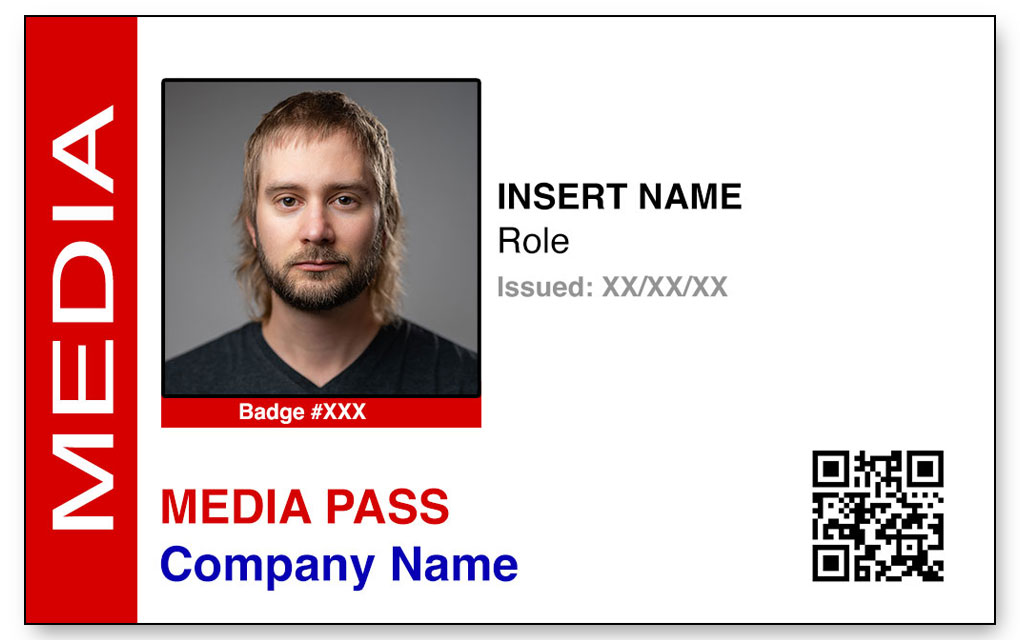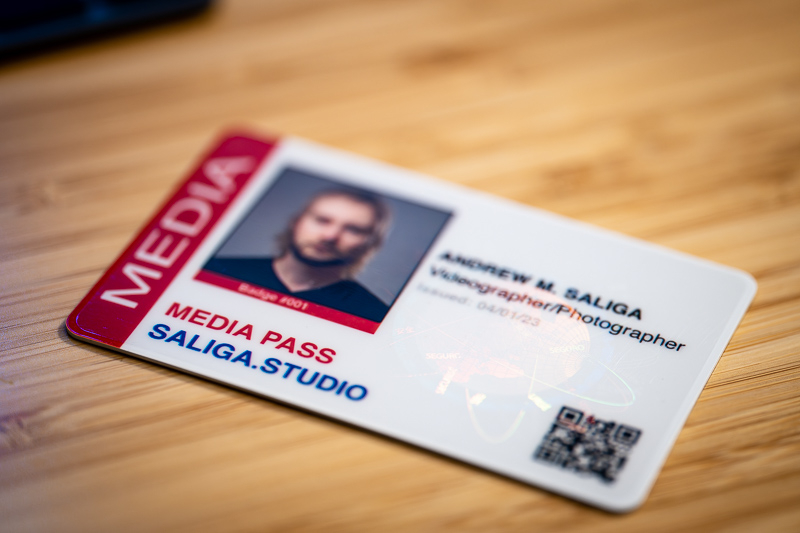Introduction to Media Passes
In the bustling world of the film industry, transporting equipment and props between locations is a common challenge. Airlines have specific baggage restrictions, but did you know that there’s a valuable tool available to filmmakers that can help overcome these limitations? Media passes, also known as press credentials, can provide exemptions and allowances for carrying essential film equipment as checked or carry-on luggage.
In this post, we’ll explore how media passes can be utilized to facilitate smoother travel experiences for filmmakers. I’ve also included a PSD template and other resources to help you create your media pass.
Understanding Media Passes
Media passes are identification cards issued to individuals who work in the media industry, such as journalists, photographers, and filmmakers. These passes are typically provided by recognized media organizations or production companies and serve as proof of affiliation. Media passes grant professionals various privileges, including access to events, interviews, and, in some cases, exemption from certain baggage restrictions.
Benefits of Media Passes for Filmmakers
Exemptions from Weight and Size Restrictions:
One of the most significant advantages of media passes is the ability to bypass or mitigate baggage weight and size restrictions imposed by airlines. Film equipment, such as cameras, lighting gear, and sound equipment, can be quite bulky and heavy. With a media pass, filmmakers can often carry equipment that exceeds the usual limits, ensuring they have the necessary tools for their projects.
As of June 2023, a summary of the media rate policies are as follows. You can also click the airline link to go to their site to confirm current policies.
$50 per piece, per one-way domestic trip, or $90 international. Up to 25 pieces, none exceeding 100 lbs. or 126 inches. Fees for overweight and oversize bags will be waived.
First and second bags same as general allowance, if no more than 50 lbs. and 62 inches, for both domestic and international trips. Flat media rate of $50 per piece, per one-way domestic trip and $70 per piece, per one-way international trip. Third to twenty-fifth bags $50 (domestic) or $70 (international) each, if no more than 100 lbs. and 115 inches.
No charge for first and second checked bag. Additional checked bags are $75 per item. No charge for overweight or oversized items.
$50 per piece, per one-way domestic trip, or $70 international, up to 99.9 lbs., including oversized bags.
Priority Boarding and Storage:
Media pass holders are often granted priority boarding privileges, allowing them to secure overhead storage space for delicate or expensive equipment. This can be crucial in ensuring the safety of fragile items and reducing the risk of damage during transit. By boarding early, filmmakers also have a better chance of finding suitable spaces for their equipment.
Security Clearance:
Media passes can also grant filmmakers expedited security screening or dedicated lanes, streamlining the often time-consuming airport security process. This not only saves time but also reduces the risk of damage or loss during manual inspections, as trained professionals handle film-related items with care.
TSA Pre-Check is also a worthwhile investment as it allows you to pass through security lines more efficiently and also shows that you’re a frequent media traveller.
Obtaining a Media Pass
Employer or Media Organization:
Typically, media passes are issued by the employing media organization or production company. As a filmmaker, consult your employer or production team to determine if they can provide you with the necessary credentials. Ensure that the pass includes a clear designation of your role within the industry. Based on my 15+ years of experience, airline employees will occasionally ask for additional identification such as a business card or credit card with the name of the business, but that is rare. When you’re checking a dozen Pelican cases at the ticketing counter, they tend to believe you.
Freelancers and Independent Filmmakers:
Freelancers and independent filmmakers may face additional challenges in obtaining media passes. However, industry associations and organizations often offer temporary passes or accreditation for specific projects or events. Explore options such as film festivals, professional guilds, or trade organizations for assistance in securing a media pass. My best advice is to have a website and a media pass that clearly identifies yourself and your business.
Tips for Traveling with a Media Pass
Communication is Key:
At the ticketing counter, inform the airline about your media pass and any exemptions you may be entitled to—be friendly. This helps ensure a smoother check-in process and prevents any misunderstandings or complications. For many airline employees, this is often the first time they have encountered someone claiming media exceptions for the number of checked bags and their overweight status. Applying these exemptions to your itinerary will often require the employee to go deep into the airline booking system or require the help of a supervisor.
Some employees are more than happy to go above and beyond, while others may find it a burden. Be patient with the ticketing agent and allow ample time before your scheduled departure to get all equipment checked in. You’re representing the entire film industry as a whole as much as you’re representing your own business.
Plan Ahead:
Although media passes provide certain exemptions, it’s important to understand that specific rules and limitations may still apply. Familiarize yourself with the airline’s policies regarding equipment and luggage, and plan accordingly. Some airlines may require prior approval or notification for oversized or overweight equipment.
I assume it’s common knowledge, but airlines have very specific requirements for lithium ion batteries. Specifically, larger V-mount and AB Gold-mount batteries need to be in a carry-on. The standard TSA rule is that you can carry up to four batteries that are under 100Wh each or two batteries that are under 160Wh each. Divvy up your checked and carry-on bags accordingly. PetaPixel has a great article that summarizes
battery policies for airlines. Check with your airline on specifics to ensure the information is current.
Protect Your Equipment:
Invest in protective cases and padding to safeguard your valuable film equipment during transit. Fragile items should be securely packed to minimize the risk of damage. Labels indicating fragile or delicate contents can also help ensure proper handling. The
Pelican 1510 case is a personal favorite, as it will fit in the overhead compartment of just about every plane, and is the maximum allowed FAA carry-on size.
AirTags are an inexpensive way to help track your checked gear. You can put the inside a case,
attach them to the interior, or even to camera equipment itself. I prefer ones that do not show the Apple logo to potential thieves. These
small silicone covers have been a great addition to my kit.
SmallRig makes one that attaches to a camera cage via a standard 1/4-20, and there are many others that cleanly tuck
inside of a lens cap.
Downloadable Media Pass Resources
Below is a Photoshop template to easily create a media pass. You can also download a PNG version of the media pass for free using this link.
If you’d like the full PSD file for simplified editing, you can download it for a $5.99 donation. 🙂
When using the PSD, you’ll update all the layers that I have labeled red.
You’ll need to update:

Once you update the layers, save the front and reverse each off as a JPG. For printing, I’ve used
QuickID Card and select the thicker option and also add the holographic security film. Turnaround time is fast, quality is good, and at under $15 a card, it’s hard to beat. Order two. Adding an
ID badge holder is also a great idea for when you need to wear your ID so it’s easily displayed.
Conclusion
In the fast-paced world of filmmaking, navigating airline luggage restrictions can be a daunting task. However, media passes offer invaluable benefits to filmmakers, allowing them to transport essential equipment and props more efficiently. By understanding the privileges associated with media passes and taking proactive steps to communicate with airlines.
I’m a photographer, 1st AC, and videographer specializing in food, beverage, and commercial production. The best way to keep up with me is via my Instagram, @a_saliga.
Cheers!

